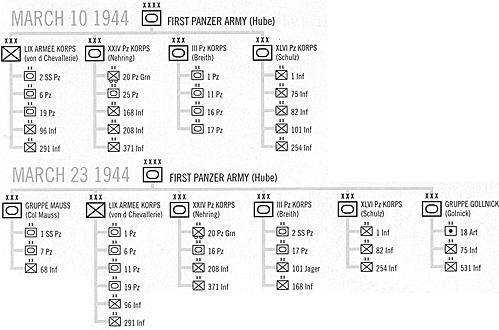 In the brief three week period the
campaign lasted First Panzer Army
underwent some staggering organization
change . Already practically an Army Group
in size before entering the battle, First Panzer
Army eventually swelled to encompass some
23 divisional sized formations, actually
exceeding the number of units trapped with
Sixth Army at Stalingrad some 18 months
previously. Amazingly, the army and its
commanders were able to cope with all the
rapid changes and even impose their will on
the situation.
In the brief three week period the
campaign lasted First Panzer Army
underwent some staggering organization
change . Already practically an Army Group
in size before entering the battle, First Panzer
Army eventually swelled to encompass some
23 divisional sized formations, actually
exceeding the number of units trapped with
Sixth Army at Stalingrad some 18 months
previously. Amazingly, the army and its
commanders were able to cope with all the
rapid changes and even impose their will on
the situation.
March 10
Prior to the battle, First Panzer Army was a bit oversized for its stated title, but possessed a respectable number of tanks, thus deserving to be called a Panzer Army (unlike its sister formations, Second and Third Panzer Armies - which lacked the strength of even a full panzer division's worth of tanks). First Panzer Army was conventionally organized, Army HQ at the top, and a corresponding number of Corps HQs to control all the subordinate divisions.
March 23
As the crisis mounted, First Panzer Army found itself exercising control over a number of lost or swept up formations from adjacent armies and rear area garrisons. In additional, a number of formerly subordinate units had become shuffled between the existing HQs. The span of control and the speed required in a tight situation was simply unsustainable for the existing HQ staffs and something needed to be done. There was great danger of it becoming a matter of "order, counter-order, disorder."
 March 28
March 28
Hobe's solution was to create an intermediate layer between his Army HQ and the Corps HQs called "Corps Groups". Placing two trusted subordinates, Breith and von der Chevallerie, in charge of these, Hobe was able to simplify his own command arrangements considerably and the pace of the breakout picked up accordingly. What is interesting to note is the lack of friction or egos among all the trapped commanders, Hobe had spoken, and everyone fell into line with the new arrangement as quickly as possible.
April 2
With the crisis averted, First Panzer Army shrank back to a more normal arrangement. The temporary Corps Groups were dissolved and the extra formations reassigned elsewhere. While typically the escape of a large trapped formation might be rewarded with leave from the front and a little rest and relaxation, in the spring of 1944 Hitler didn't have a spare army (let alone a spare panzer army) to plug the line with. So the by now fewer troops in First Panzer Army resumed fending off the Soviets as best they could. Fortunately for them, Soviet eyes soon turned towards the Crimea.
Kesselschlacht March-April 1944
- Introduction and Background
Terrain and Weather
The Deception
The Battle Begins
Breakout
Aftermath
The Face of Battle
All Daily Situation Maps (monstrously slow: 1.646Mb!)
Back to Table of Contents -- Against the Odds vol. 1 no. 3
Back to Against the Odds List of Issues
Back to MagWeb Magazine List
© Copyright 2002 by LPS.
This article appears in MagWeb.com (Magazine Web) on the Internet World Wide Web.
Other articles from military history and related magazines are available at http://www.magweb.com
* Buy this back issue or subscribe to Against the Odds direct from LPS.
